Kumamoto City, Kumamoto Prefecture
Late Kofun period (middle portion, sixth century)
Round mound with painting (red, blue [grey], white)
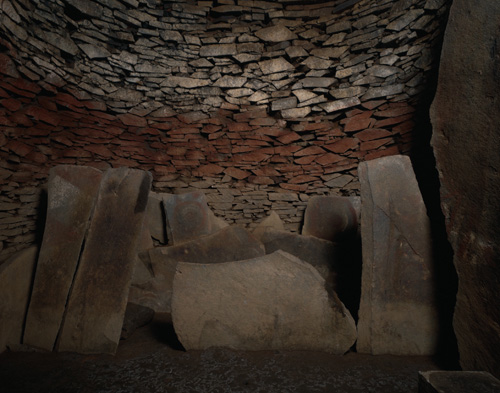
Rear wall of the burial chamber and the decorations on the roofed burial compartment (prior to damage) The burial compartment had already lost its original shape, but patterns of circles, triangles, and sōkyaku rinjōmon are visible.
Drawings of the stone chamber

Ceiling stone over the entrance to the inner chamber (prior to damage)
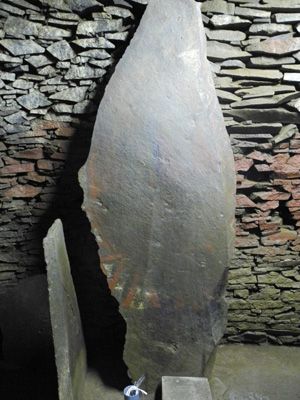
Ceiling stone of the roofed burial compartment (prior to damage)

Back wall of the roofed burial compartment (prior to damage)

Condition prior to damage The horizontal stone chamber entrance is open.
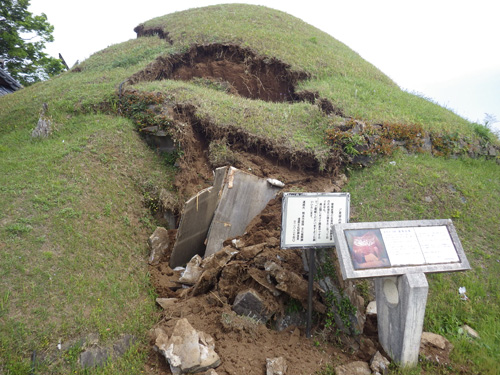
Condition immediately after the damage Dirt of the mound has greatly crumbled, and the entrance to the horizontal stone chamber is blocked shut.
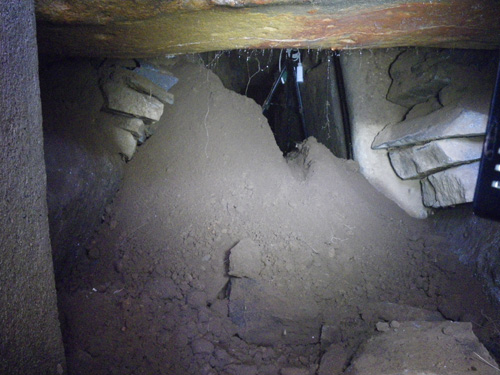
Dirt that flowed into the stone chamber After the damage, it was seen that the wall had collapsed and dirt had flowed into the passageway.
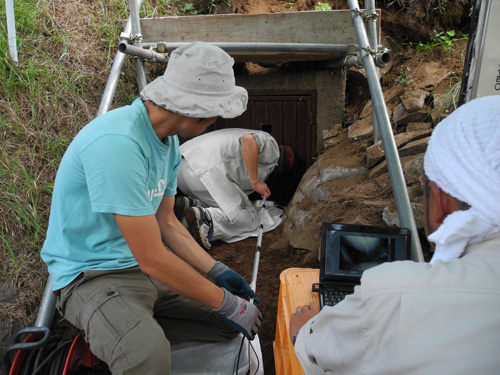
Checking conditions within the stone chamber As directly entering the stone chamber had become dangerous, conditions after the damage were checked by extending a camera into the chamber.
Drawings of the decorations (Figures are all adapted from Kumamoto-ken sōshoku kofun sōgō chōsa hōkokusho [Comprehensive investigation report on decorated tombs of Kumamoto prefecture], Takaki Masafumi, ed., Kumamoto Prefecture Board of Education, 1984). Adapted from Hakkutsu sareta Nihon rettō 2018 [Excavations in the Japanese Archipelago, 2018] (Bunkachō [Agency for Cultural Affairs], ed., Kyodo News, 2018).
A round mound with a rare sōkyaku rinjōmon pattern
A large-scale round mound where a local figure of power rests
The Kamao tomb sits atop a hill at the base of Mt. Kinbō which soars above the western portion of the city of Kumamoto. The location has an extremely fine outlook, with a clear view from the plain directly below to Mt. Aso in the distance. The tomb has been protected by the hands of many people since its discovery in 1769, during the Edo period. In 1918 an excavation was conducted by Kyoto Imperial University, and in 1921 it was nationally designated a Historic Site. Repair work for conservation has been carried out repeatedly, and in 1967 the horizontal stone chamber was encased in concrete, around which dirt was piled with the aim of protecting the tomb.
From the results of investigations thus far the Kamao tomb is regarded as a round mound of about 30 m diameter built in the Late Kofun period (middle portion of the sixth century), within which a powerful local figure who ruled the region was buried.
A major characteristic of Kamao is its being a tomb decorated with a great variety of designs. These are drawn in the three colors of red, blue (grey), and white, and in addition to geometric patterns of circles and triangles there is one called sōkyaku rinjōmon (literally, “double-legged ring-shaped pattern”) for which the thematic content remains unidentified. These designs are said to have been imbued with the magical meaning of protecting the deceased who was buried there. Incidentally, while there are more than 600 decorated tombs known for the country, only a few examples have been found in which the sōkyaku rinjōmon was drawn.
The Kamao tomb is thus one in which a local figure of power rests, in addition to being a rare decorated tomb drawn with the sōkyaku rinjōmon, and as such has long been protected as one of the first Historic Sites designated in Japan.
Entrance is blocked as the stones collapse
The 2016 Kumamoto earthquakes inflicted severe damage on the Kamao tomb, which had thus been protected with great care. Dirt comprising the mound crumbled due to the quakes while the stone chamber was also damaged as the stone material broke or collapsed, and in addition dirt flowed into the chamber making it impossible to enter. Accordingly, the condition of the precious decorations drawn within the chamber could not be directly ascertained.
The city of Kumamoto is currently conducting a detailed investigation of the state of the damage, for the purpose of restoring the Kamao tomb. The survey is focusing on the degree of damage suffered by the stone chamber, the presence and degree of any damage to the decorations, and the condition of the concrete casing that protects the horizontal stone chamber. As work on the crumbled mound or within the stone chamber is dangerous, steady operations while maintaining safety are called for, but the data obtained will be vital for considerations of restoration measures.
From here, the optimal means of repair based on these data will be studied, and efforts made at restoration that will securely preserve the Kamao tomb for the future. (Miyoshi Eitarō)

